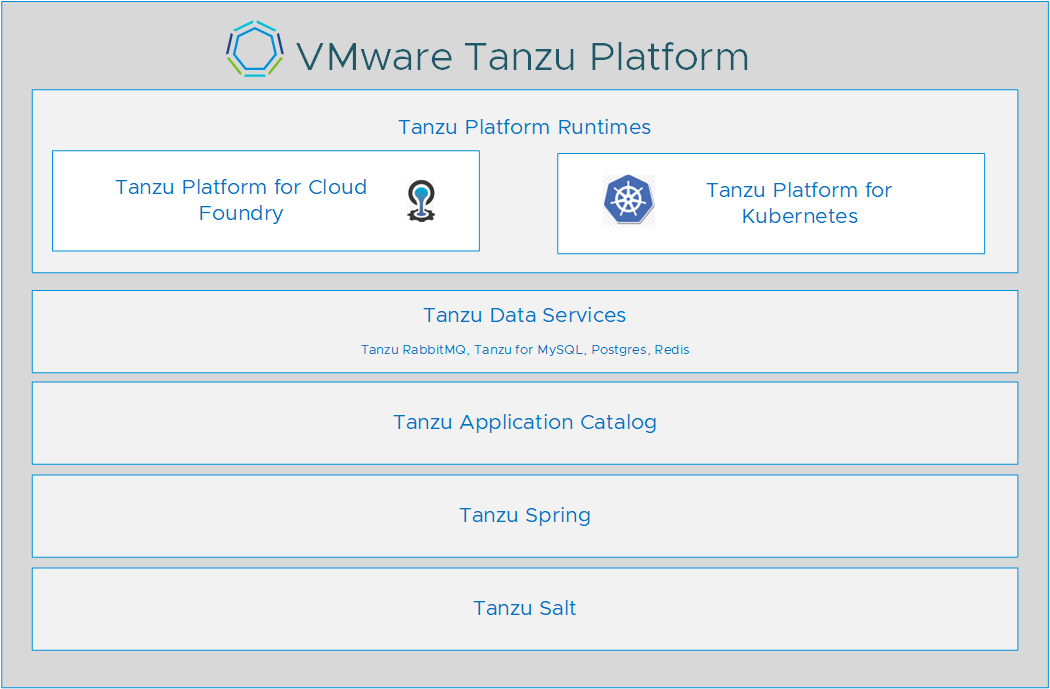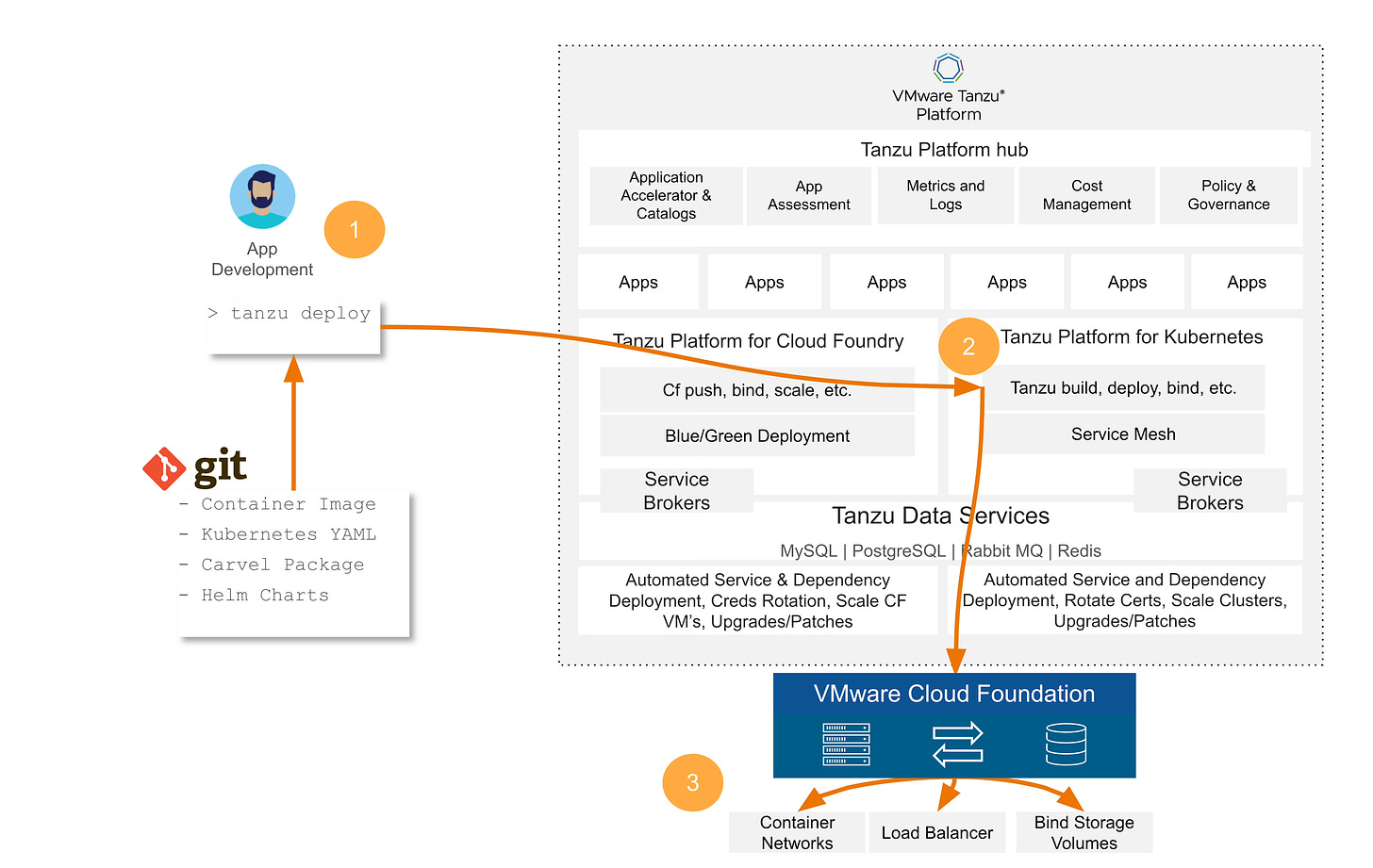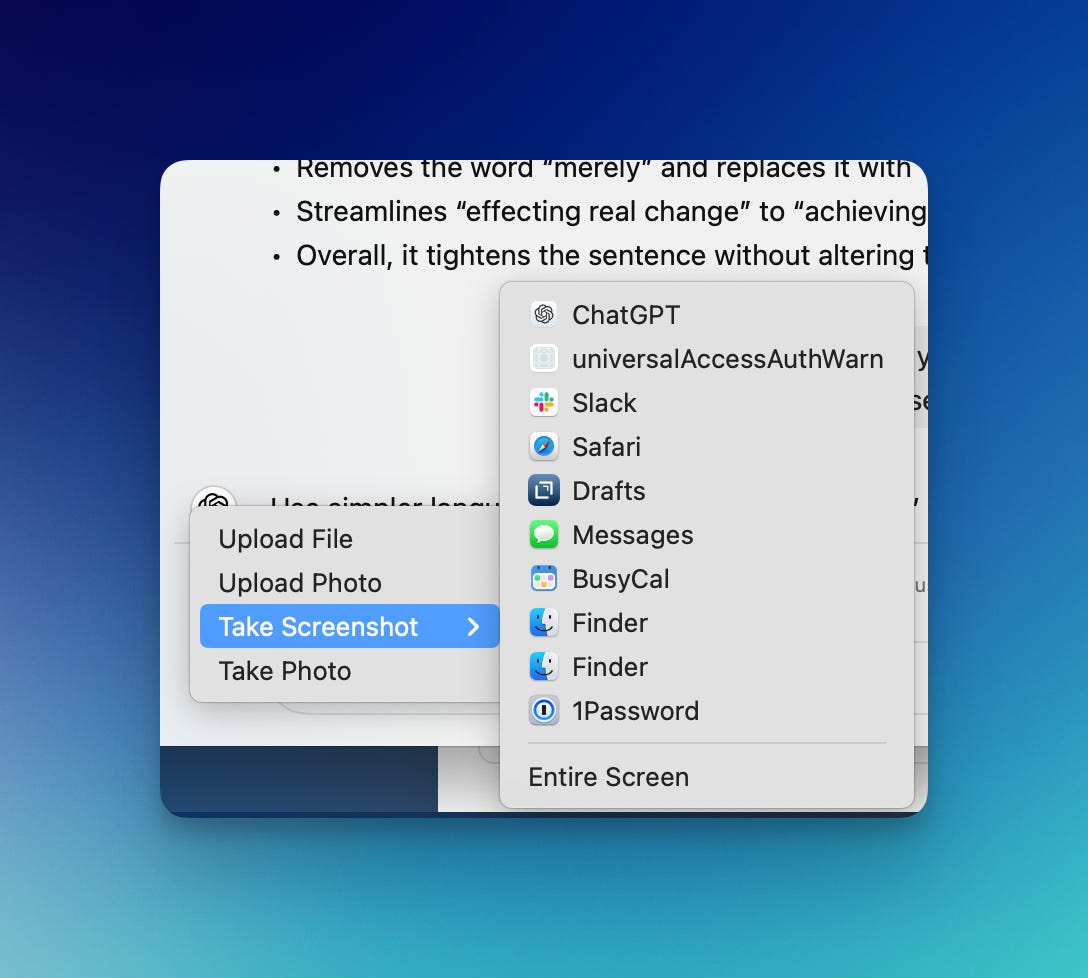The Tanzu Platform - platform engineering in a box for private cloud
This week, at my work, we launched the Tanzu Platform. This is both actual, new things and strategic tuning of many of our existing products. In brief, we’re focusing a lot more on private cloud PaaS now, and private cloud data services. (Sure, you can do public cloud stuff too, and our customers tend to both, with a lot of private cloud.)
The Tanzu Platform needs some kind of IaaS “dial tone” (either VMware or Kubernetes) and then you can run a multi-tenant, global PaaS, get integrated DevOps/platform engineering tooling, enterprise security and governance, and get integration benefits all the way up to the app layer with things like the Spring Framework (for Java). When platform engineering people talk about building a platform, that’s exactly what the Tanzu Platform is: a platform.
And, if you’re working at a large organization, chance are you already have the Tanzu Platform in place. This also means you probably have generative AI in a box available to add. No need to ponder building a new stack from scratch.
Unlike a lot of the work being done right now in platform engineering, the Tanzu Platform has existed for many, many years, is used in numerous production environments with uncountable applications. That is, it’s proven, comprehensible, usable, integrated, and available. If you want to know what platform engineering is in product/stack and in practice, look at the Tanzu Platform and Tanzu Data Services.
(I didn’t, like, run that by anyone at work this Saturday morning. It’s how I think of it. So, like: opinions are my own not my company’s, etc., etc. You can read the fully corporate-pondered overview on the weblog.)
Learning to love Enterprise Software
Speaking of the Tanzu Platform, I talked about it in the first segment of this week’s Software Defined Talk episode. The episode opens with me commenting on the new, unnamed expensing software I get to use. Then after a brief Tanzu Platform discussion, we spend most of the time talking about Microsoft Build, and a little bit about the prospect of Raspberry Pi IPO’ing. Listen it, or watch the unedited video. Or both!
Right-side Up Pyramid Style
I read some contemporary, public-facing philosophy recently. My degree is in philosophy (and English), so why not? My thought: who is this written for?1 It was just a bunch of circumlocutious writing with endless references to Continental philosophers - even Kant! And don’t get me started on how much the word “Hegelian” came up.
One could say my mind has been warped by corporate communication (PowerPoint, industry analyst reports, Mento memo’ing) and blogging…but, really: just the medium of how we communicate now - clear, concise, to the point - is a big challenge for philosophy writing, and I assume humanities writing in general.
There’s no need for that baroque style we call “academic”! You could just come out and say what you’re thinking.
But, the art of philosophy writing has always been obtuse. To make it visual, humanities academic writing is like abstract art: you have work at it to see what’s there, appreciate what’s going, get some utility out of it.
However, I think that’s one of the major points of academic writing. There’s a sport to reading it and liking it.
So much of philosophy writing - and literary academic writing - is entertainment for those writing it and reading it. Is there a dichotomy there: writing for academic perfection and pleasure versus writing for clarity and action?
If Kant or Hegel were bloggers, or, better, Tweeters, what they were saying would be so much different - the medium would change it. And, I probably would have read more of them. You could look at different mediums in philosophy to see how the medium changed the outcomes: Plato with “dialogs” (really, just very boring plays, contemporaneously they’d be movies/TV, or Broadway musicals), Nietzsche with aphorisms (contemporaneously, greeting cards, smug coffee mugs, and bumper-stickers).
Anyhow. Back to inverted pyramid mode.
ChatGPT on MacOS
I have access to the MacOS ChatGPT thing now. It's the same as the other desktop GPT overlays I've used like Jordi Bruin's stuff. Too bad for Jordi! Or, maybe, too great, cause now he’ll do some new, great features.
I didn’t use his stuff because it was just a wrapper for the web ChatGPT Plus, or you had to put your own OpenAI token in and get metered usage. I’ll see if I end up using the desktop ChatGPT from ChatGPT more. That kind of nudge to change behavior - it’s the official one rather a third party - would be an interesting…uh?…”UI bias”
I think the only "new" thing it gets you is the voice interaction which was only on the iOS app previously. I like this on the mobile app, but connectivity made it hard to use. Maybe with my wired, gigabit connection on my desktop it’d be better.2
It still doesn't have the ability to download the transcript for a single chat session. This seems bonkers.
Also, the UI is exactly like the web UI in layout, functionality, etc.
OK, there is a slightly new thing: collapsing a screenshot workflow into an app feature. Once you give it access, you can have it auto-upload a screenshot:
I didn’t give it access to record my screen. I mean, obviously they’re on their own ethical vibe over there.
Wastebook
All jargon is meaningful, just maybe not to you.
Coté’s calendar style: quick to decline, slow to accept.
It’d be fun, if when I fly from a distant time zone to another (ATL to AMS), when I opened my laptop it had a moment of geo-confusion just like me. Error: where am I?
“Sort of a lunch-pail occupation.” Gruber.
The obligation to argue accepted truth, as opposed to the obligation to plan your family’s annual vacation.
“If a developer hasn’t gulped down their AI pills and pulled on their Copilot pants, Microsoft doesn’t seem that interested.” Here.
Conferences, Events, etc.
Talks I’m giving, places I’ll be, and other plans.
SpringOne Tour London, June 5th. DATEV Software Craft Community online, June 6th, speaking. DevOpsDays Amsterdam, June 20th, speaking. NDC Oslo, speaking, June 12th. SpringOne/VMware Explore US, August 26–29, 2024. SREday London 2024, September 19th to 20th.
Discounts. SREDay London (Sep 19th to 20th) when you 20% off with the code SRE20DAY. And, if you register for SpringOne/VMware Explore before June 11th, you’ll get $400 off.
Logoff
I’m back in Amsterdam after a week in Atlanta. The new, “expat goes back to the States” thing I noticed is that some Americans will wear a short-sleeved golf shirt with slacks and figure that’s good enough work attire. Also, they tuck in the golf shirt.
I can’t imagine Europeans doing this, or, really, wearing golf shirts at all outside of…golf. Even a t-shirt would be more “normal”: there’s something about the plastic sheen of a golf shirt and those two or so little buttons on-top that makes it so much different than a t-shirt. Now, a polo shirt…this might be acceptable if it was properly branded with a classic polo brand or “Boss.”3 I’m not sure though, I’ll have to start noticing.
And, as ever, what they do over in UKI might be more Yankee-Continental than Continental-Continental.
This feels like a fun thing to start asking AIs when they summarize text.
Also, while the reaction to the Sky voice isn’t really, like, shocking, that it took this long is weird. I’ve been using Sky since that feature came out, and I think I even commented on the podcast that it was clearly a rip-off. I guess a lot of people didn’t subscribe to and use ChatGPT Plus? Also, I miss that voice - it was great! Hopefully they can figure out getting it back. The other voices are way too…artificially cheery.
The popularity of the Hugo Boss brand in Europe is an ongoing curiosity to me. Also: Gant. ¯\_(ツ)_/¯



